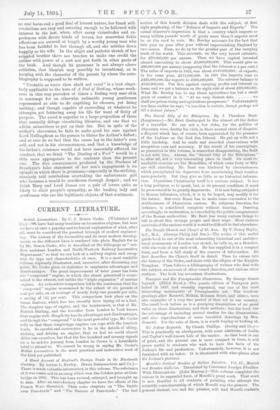CURRENT LITERATURE.
British Locomotives. By C. J. Bowen Cooke. (Whittaker and sCo.)—Vile have had many treatises on locomotive engines, but here we have at once a popular and technical explanation of what, after must be considered the greatest triumph of modern engineer- ing. The history of the locomotive and its most modern develop- ments on the different lines is rendered into plain English for Us ?by Mr. Bowen Cooke, who is described on the title-page as " out- door assistant London and North-Western Railway Locomotive Department," so that we can look at a railway engine and recog- nise its type and characteristics at once. It is a most readable 'volume, copiously illustrated, and, moreover, after discussing any point, Mr. Cooke gives us statistics to emphasise advantages and -disadvantages. The great improvement of later years has been the " compound " engine, in which the steam generated is econo- mised to the utmost, not unlike the "triple expansion" of marine sngines. An exhaustive comparison led to the conclusion that the "compound" engine economised to the extent of six pounds of coal per mile, on an average of nearly forty-one pounds per mile, a saving of 141 per cent. This comparison took place on the Great Eastern, which lino has recently been trying oil as a fuel. The simplest type of engine, and the handsomest, is that of Mr. Patrick Stirling, and the traveller from London to York knows that engine well. Simplicity has its advantages and. disadvantages, . and though the " compound " is the most powerful type, Mr. Cooke tells us that these simple-type engines can cope with the heaviest loads. So careful and instructive is he in the details of oiling, stoking, and driving an engine, that we feel we could almost drive one ourselvee, but that the five hundred and seventy signals on a to-and-fro journey from London to Crewe is a formidable total to attend to. Vire cannot be wrong in saying Mr. Cooke's British locomotives is the most practical and instructive work of the kind yet published.


































 Previous page
Previous page